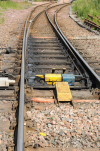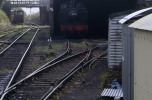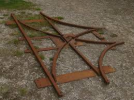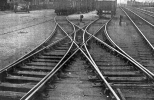justme igor
Registered
Source: TU Delft(the Netherlands)
Turnouts differ in sizes. Some commonly used ones are shown below. The number after '1:' stands for the angle of intersection. The length and the maximum allowable speed to pass the turnout in the divergent direction are given below as well.
1:9 - 32 meter - 40 km/h
1:12 - 38 meter - 60 km/h
1:15 - 47 meter - 80 km/h
1:34 - 99 meter - 140 km/h
.......
So when i am wanting to build my tracks prototypical correct and my "average real life speed" will be 70 km/h i will need a 1:15 turnout.
But when i do my calculations for 1:32 modelling i can not get the 47 meters, i get a 1 meter turnout that should be 32 meters in real life.
32 / 47 meters is in my scale 68,01 cm...
But i get a turnout of 102 cm...(would be in real life 99 meters aka 1:34---->140 km/h
With a radii of 581cm in: 1:9, 1:12, 1:15 and 1:34, so a radii below 5 meter is out of the question...need to redesign, no problem...time=problem
What do i miss here, where did i go wrong?
I dont think this question is appropriate to ask in class sinds we are handling prototypical and not model?
(studying railway engineering)
Thanks in advance, with best regards Igor
Turnouts differ in sizes. Some commonly used ones are shown below. The number after '1:' stands for the angle of intersection. The length and the maximum allowable speed to pass the turnout in the divergent direction are given below as well.
1:9 - 32 meter - 40 km/h
1:12 - 38 meter - 60 km/h
1:15 - 47 meter - 80 km/h
1:34 - 99 meter - 140 km/h
.......
So when i am wanting to build my tracks prototypical correct and my "average real life speed" will be 70 km/h i will need a 1:15 turnout.
But when i do my calculations for 1:32 modelling i can not get the 47 meters, i get a 1 meter turnout that should be 32 meters in real life.
32 / 47 meters is in my scale 68,01 cm...
But i get a turnout of 102 cm...(would be in real life 99 meters aka 1:34---->140 km/h
With a radii of 581cm in: 1:9, 1:12, 1:15 and 1:34, so a radii below 5 meter is out of the question...need to redesign, no problem...time=problem
What do i miss here, where did i go wrong?
I dont think this question is appropriate to ask in class sinds we are handling prototypical and not model?
(studying railway engineering)
Thanks in advance, with best regards Igor




